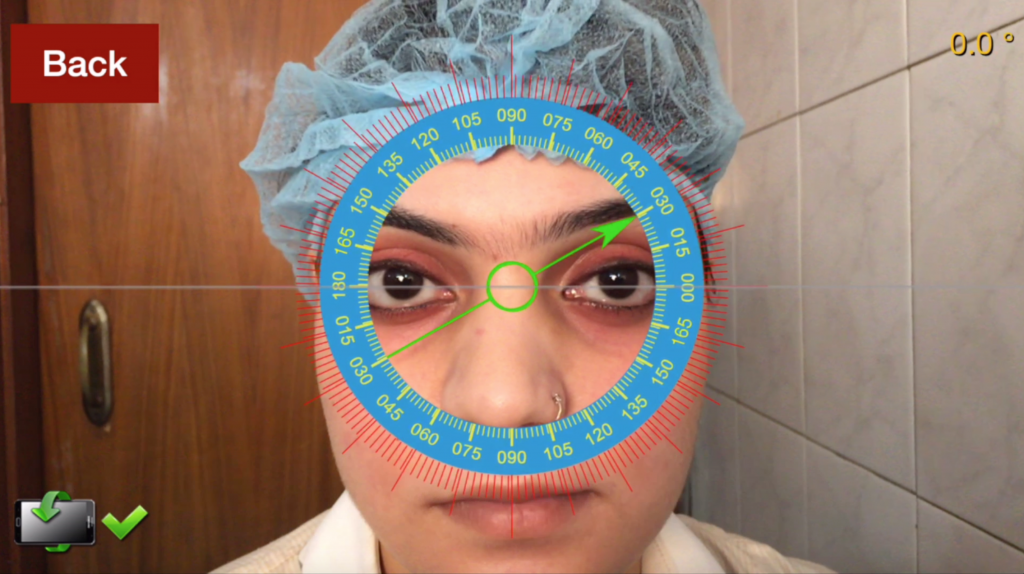Alignment techniques compared
Mobile app-based guidance compares favourably with digital axis marking system

Cheryl Guttman Krader
Published: Friday, May 1, 2020
 Screenshot from the Toraxis digital marking app for alignment of toric intraocular lenses. Image courtesy of Rahil Chaudhary MD
A mobile app digital reference marker offers cataract surgeons an inexpensive, consistent, and reproducible way to enhance outcomes of toric IOL surgery, reported Rahil Chaudhary MD, at the 37th Congress of the ESCRS in Paris, France.
Dr Chaudhary and colleagues from Eye7 Chaudhary Eye Centre, New Delhi, India, investigated the performance of Toraxis (iOS/App Store), a mobile app designed to help guide intraoperative toric IOL alignment, by comparing its accuracy with that of a digital axis marking system (Verion, Alcon) and the use of a manual horizontal bubble marker.
“Smartphone apps are being increasingly used by healthcare professionals, and ophthalmological toric IOL axis marking apps are easily available for download,” said Dr Chaudhary.
“The purpose of our study was to assess the accuracy of one particular reference marking app. Although we found that it was not as good as the digital marking system, the results of the mobile app were consistent with the results of the digital marking system and associated with less variability than the manual bubble marker.”
The app investigated in this study is a non-contact approach that does not involve ink markings. It takes a high-definition image of the eye from which the user identifies an anatomical landmark, such as a prominent blood vessel. The app establishes the angle coordinates of the landmark as a reference for determining the axis of astigmatism that is then identified intraoperatively using a Mendez ring or a surgical microscope-integrated overlay.
The study assessing the accuracy of the mobile app included 50 eyes. All three systems for guiding toric IOL alignment were used in all cases. All marks were made by a single surgeon, and the data of the mobile app marker and digital axis marker were collected by the same surgeon.
Assuming that the digital axis marker represented the most accurate technique, it was used as the “gold standard” reference for analysing the accuracy of the mobile app and manual marking system. Compared with the axis of alignment identified with the digital axis marker, mean (± standard deviation) variability was 1.8±1.1 degrees for the mobile app and 3.2±1.8 degrees for the manual bubble marker (P<.0001).
Based on the study findings, Dr Chaudhary suggested the mobile app is something that surgeons could consider using for confirmation of reference marks that are manually placed preoperatively.
Rahil Chaudhary: rahilchaudhary@gmail.com
Screenshot from the Toraxis digital marking app for alignment of toric intraocular lenses. Image courtesy of Rahil Chaudhary MD
A mobile app digital reference marker offers cataract surgeons an inexpensive, consistent, and reproducible way to enhance outcomes of toric IOL surgery, reported Rahil Chaudhary MD, at the 37th Congress of the ESCRS in Paris, France.
Dr Chaudhary and colleagues from Eye7 Chaudhary Eye Centre, New Delhi, India, investigated the performance of Toraxis (iOS/App Store), a mobile app designed to help guide intraoperative toric IOL alignment, by comparing its accuracy with that of a digital axis marking system (Verion, Alcon) and the use of a manual horizontal bubble marker.
“Smartphone apps are being increasingly used by healthcare professionals, and ophthalmological toric IOL axis marking apps are easily available for download,” said Dr Chaudhary.
“The purpose of our study was to assess the accuracy of one particular reference marking app. Although we found that it was not as good as the digital marking system, the results of the mobile app were consistent with the results of the digital marking system and associated with less variability than the manual bubble marker.”
The app investigated in this study is a non-contact approach that does not involve ink markings. It takes a high-definition image of the eye from which the user identifies an anatomical landmark, such as a prominent blood vessel. The app establishes the angle coordinates of the landmark as a reference for determining the axis of astigmatism that is then identified intraoperatively using a Mendez ring or a surgical microscope-integrated overlay.
The study assessing the accuracy of the mobile app included 50 eyes. All three systems for guiding toric IOL alignment were used in all cases. All marks were made by a single surgeon, and the data of the mobile app marker and digital axis marker were collected by the same surgeon.
Assuming that the digital axis marker represented the most accurate technique, it was used as the “gold standard” reference for analysing the accuracy of the mobile app and manual marking system. Compared with the axis of alignment identified with the digital axis marker, mean (± standard deviation) variability was 1.8±1.1 degrees for the mobile app and 3.2±1.8 degrees for the manual bubble marker (P<.0001).
Based on the study findings, Dr Chaudhary suggested the mobile app is something that surgeons could consider using for confirmation of reference marks that are manually placed preoperatively.
Rahil Chaudhary: rahilchaudhary@gmail.com